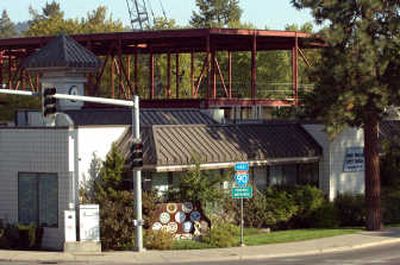Old City Hall heads to a vote

POST FALLS – With only 18 days until next month’s municipal election, the debate over whether to spare Post Falls’ current City Ball building is reaching a crescendo.
City officials had planned to demolish the structure next year. Some residents want to save the old building for public use, such as a museum. Others say that would cost too much. The debate has divided the fast-growing city of more than 25,000, and voters will decide in the Nov. 6 city election if the building stays or goes.
Preserving the 7,500-square-foot structure at this late date would cause a financial crisis, said City Administrator Eric Keck. Taxpayers would have to foot the estimated $1.2 million bill, plus pay $60,000 a year in operating costs. And they’d get an aging building fraught with maintenance problems, Keck said.
On the other side is Bob Templin, a longtime community leader and founder of Red Lion Templin’s Hotel on the River. He’s heading up a campaign to save old City Hall, scheduled to be torn down after its 41,000-square-foot, $8.8 million replacement is finished next spring.
When the city held a public hearing on the plan last year, no one objected to razing the old building, Keck said. But over the summer, Templin launched a petition drive that put the issue on the ballot.
Templin, 84, maintains the city has exaggerated the cost to preserve the building, which will be a bargain. “I feel it’s a good building yet and it should be retained,” he said.
Both the old and new City Halls are in the City Center District, bordered by Interstate 90 on the north and the Spokane River on the south. It’s where community leaders hope to create a sense of downtown in a city whose population is expected to double in 20 years.
Among the fastest-growing towns in Idaho, Post Falls is bursting at the seams. In less than two years, there has been about $65 million in residential developments, giant retailers such as Cabela’s, light industry and manufacturing facilities, said Mayor Clay Larkin.
The main drag, Seltice Way, stretches six miles in the city with its many businesses.
But Templin believes old City Hall fits the downtown vision. It’s compatible with the Old Church Community Center, the new two-story City Hall, and nearby parks and trails, he said. And if the city revitalizes the area, the building would be surrounded by landscaped streets, sidewalks with river-themed embellishments, lampposts and parking.
So why the squabble over an old building in need of massive repairs, yet not old enough to qualify for the National Register of Historic Places?
It boils down to money, possible tax increases and terrible timing, Keck said.
“The city looked at (preservation) over and over,” he said. City Council studied its options carefully, and tearing down the building “made sense each and every time.”
If voters keep the old building, the city will need to dig up and move underground phone, gas, electric, water and sewer lines, Keck said. The utilities were located with the expectation that old City Hall would soon be gone. Likewise, a new storm swale slopes toward the building’s front door, Keck said. On top of that, the structure needs a roof, plumbing, insulation, energy-efficient windows, ceiling tiles and repairs to cracking walls, he said.
“The most important thing for people to know,” Keck said, “is there are real costs associated with preserving old City Hall. And those costs are substantial.”
That’s why the city has placed a second question on the Nov. 6 ballot: If voters want to save the old building, would they also support a tax levy to pay for needed improvements and modifications. If not, the city would need to cut staff and services, officials say.
Templin’s analysis shows it would cost about $56,000 a year to keep up the old City Hall, and all of that could come from future tenants.
“And I don’t think we could replace it for $1 million,” making it a bargain even after the cost of relocating utilities and bringing it up to code, he said.
He said many people have applauded his efforts to try to save the building. Last week, a group calling themselves charter members and friends of the Post Falls Historical Society said the city steamrolled them in reaching its demolition decision. They’re lobbying to keep the building for the historical society’s museum.
“Is a grassy swale more important than the preservation of the ongoing story of the people and the land?” they ask in a letter signed by Templin and four others. But Sharon Alexander, society president, in a statement Friday said the society decided to relocate the museum to the turn-of-the-century Chapin Building, an old drugstore and soda fountain, which the city is making available for a nominal fee. It’s on the same block as the old City Hall.
Alexander is incensed that a splinter group is passing itself off as society members.
“Any use of the Post Falls Historical Society’s name during the debate surrounding the future status of the current City Hall is being done without its permission,” she wrote.
Another new group, Citizens for Responsible Spending, emerged last week urging residents to vote down the preservation initiative and tax increase.
At the center of that effort are Patrick Hoffer, son of the city’s public relations liaison Kit Hoffer, and Alison McArthur, the mayor’s daughter. The two insist their parents had no hand in their decision to lobby for the building’s destruction.
The organization will take out advertisements, post yard signs and go door to door, Patrick Hoffer said.
Meanwhile, Templin is circulating his own financial analysis and helping pass out save City Hall documents. The city has produced brochures showing that a one-time levy of about $111 on a $250,000 house would be necessary to save old City Hall.
“Preservation is something the city’s concerned with,” Keck said. “But it’s preservation where it makes sense.”